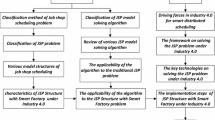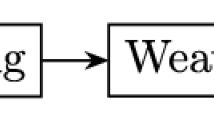Abstract
Flexible manufacturing cells (FMCs) are now common place in many manufacturing companies, due to their numerous advantages such as the production of a wide range of part types with short lead times, low work-in-progress, economical production of small batches and high resource utilization. Part and tool flows, two major dynamic entities, are the key factors and their management plays an important role in the operation of a FMC. The theme of this paper is to a generate joint operation - tool schedule in a FMC consisting of several machines and a common tool magazine (CTM). To achieve this aim, the jobs and tools must be jointly sequenced and scheduled in a tool constrained environment. Two heuristic algorithms, priority dispatching rules algorithm (PDRA) and simulated annealing algorithm (SAA) are proposed to derive optimal solutions. PDRA, are the most frequently applied heuristics for solving job shop/combinatorial scheduling problems in practice because of their ease of implementation and their low complexity, when compared with excel algorithms. SAA that belong to search categories, which are emerging along with the high computational capability of computers, can be used for FMS scheduling problems. Both adopt the Giffler & Thompson procedure for active feasible schedule generation. The performance of these two algorithms is compared with makespan and computational time. The analysis reveals that the SAA based heuristic provides an optimal or near optimal solution with reasonable computational time.
Similar content being viewed by others
References
Roh HK, Kim YD (1997) Due-date based loading and scheduling methods for a flexible manufacturing system with an automatic tool transporter. Int J Prod Res 35(11):2989–3003
Rahimifard S, Newman ST (1997) Simultaneous scheduling of work pieces, fixtures and cutting tools with in FMCs. Int J Prod Res 35(9):2379–2396
Jawahar N, Aravindan P, Ponnambalam SG (1998) A genetic algorithm for scheduling flexible manufacturing systems. Int J Adv Manuf Technol 14:588–607
Selim Akturk M, Siraceddin O (1999) Joint lot sizing and tool management in a CNC environment. Comput Ind 40:61–74
French S (1982) Sequencing and scheduling, 5th edn. Hardwood, London
Brucker P (1995) Scheduling algorithm, 1st edn. Springer, Berlin Heidelberg New York
Mukhopadhyay SK, Nandi PK (1999) Solving tool allocation problem in flexible manufacturing system. Ind Eng (India) J 80:16–20
Jun H-B, Kim Y-D, Suh H-W (1999) Heuristics for a tool provisioning problem in a flexible manufacturing system with an automatic tool transporter. IEEE Trans Robot Automat 15(3):488–496
Gray AE, Seidmann A, Stecke KE (1990) A synthesis of decision models for tool management in automated manufacturing. Manage Sci 39:249–567
Kahator SK, Leung LC (1994) Intermediate tool requirement planning for FMS. J Manuf Syst 13(1):9–19
Gargeya VB, Deane RH (1999) Scheduling in the dynamic job shop under auxiliary resource constraints: a simulation study. Int J Prod Res 37(12):2817–2834
Veeramani D, Upon DM, Barash MM (1992) Cutting-tool in computer-integrated manufacturing. Int J Flex Manuf Syst 4:237–265
Kusiak A (1986) Parts and tools handling systems. In: Kusiak A (ed) Modelling and design of flexible manufacturing systems. Elsevier, Amsterdam, pp 99–109
Tomek P, (1986) Tooling concept for FMS. In: Rathmill K (ed) Proc 5th International Conference of FMS. IFS, New York, pp 315–326
Han MH, Na YK, Hogg GL (1989) Real-time tool control and job dispatching in flexible manufacturing systems. Int J Prod Res 27:1257–1267
Kwasi A-G, Mededith JR, Raturi A (1992) A comparison of tool management strategies and part selection rules for flexible manufacturing systems. Int J Prod Res 30:733–748
Agnetis A, Alfieri A, Brandimarte P, Prinsecchi P (1997) Joint job/tool scheduling in a FMC with no on-board tool magazine. Comput Integr Manuf Syst 10(1):61–68
Eglese RW (1990) Simulated annealing: a tool for operational research. Eur J Oper Res 46:271–281
Tiwari MK, Vidyarthi NK (2000) Solving machine loading problems in a flexible manufacturing system using a genetic algorithm based heuristic approach. Int J Prod Res 38(14):3357–3384
Giffler B, Thompson GL (1960) Algorithms for solving production scheduling problems. Int J Oper Res 8:487–503
Nascimento MA (1993) Giffler and Thompson algorithm for job shop scheduling is still good for flexible manufacturing systems. J Oper Res Soc 44(5):521–524
Waikar AM, Sarkar BR, Lal AM (1995) A comparative study of some priority dispatching rules under different shop loads. Int J Prod Plan Control 6(4):301–310
Kirkpatrick S, Gelatt CD, Vecchi MP (1983) Optimization by simulated annealing. Science 220:671–680
Cerny V (1985) Thermo dynamical approach to the travelling salesman problem: an efficient simulation algorithm. J Optim Theory Appl 45:41–45
Metropolis N, Rosenbluth A, Rosenbluth M, Teller A, Teller E (1953) Equation of state calculations by fast computing machines. J Chem Phys 21:1087–1092
Zeogordi SH, Itoh K, Enkawa T (1995) A knowledgeable simulated annealing scheme for the early/tardy flow shop scheduling problem. Int J Prod Res 33(5):1449–1466
Radhakrishnan S, Ventura JA (2000) Simulated annealing for parallel machine scheduling with earliness – tardiness penalties and sequence – dependent set-up times. Int J Prod Res 38(10):233–2252
Steinhofel K, Albrecht a (1999) Wong CK, Theory and methodology – Two simulated annealing-based heuristics for the job shop scheduling problem. Eur J Oper Res 118:524–548
Gangadharan R, Rajendran C (1994) A simulated annealing heuristic for scheduling in a flow shop with bicriteria. Comput Ind Eng 27(1–4):473–476
Parthasarathy S, Rajendran C (1998) Scheduling to minimize mean tardiness and weighted mean tardiness in flow shop and flow line-based manufacturing cell. Comput Ind Eng 34(2):531–546
Author information
Authors and Affiliations
Corresponding author
Rights and permissions
About this article
Cite this article
Prabaharan, T., Nakkeeran, P. & Jawahar, N. Sequencing and scheduling of job and tool in a flexible manufacturing cell. Int J Adv Manuf Technol 29, 729–745 (2006). https://doi.org/10.1007/s00170-005-2567-3
Received:
Accepted:
Published:
Issue Date:
DOI: https://doi.org/10.1007/s00170-005-2567-3




